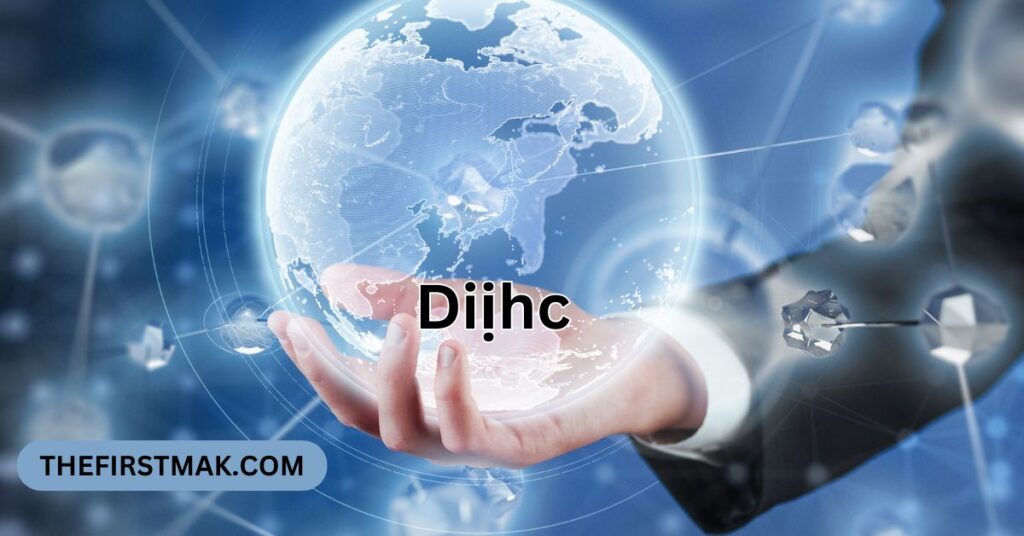
Contents
- 1 What is Diịhc?
- 2 Significance of Diịhc
- 3 How AI enhances decision-making
- 4 Impact on employment
- 5 Integration with the Internet of Things
- 6 Security and privacy concerns
- 7 The future of AI and tech
- 8 Ethical AI and algorithmic bias
- 9 Synthetic biology and bio-inspired tech
- 10 Conclusion
- 11 FAQs
- 11.0.1 1. How does Diịhc impact job security?
- 11.0.2 2. What are the ethical implications of AI?
- 11.0.3 3. How does Diịhc work?
- 11.0.4 4. What are the key benefits of using Diịhc?
- 11.0.5 5. In which industries can Diịhc be applied?
- 11.0.6 6. Is Diịhc compatible with existing tech infrastructure?
- 11.0.7 7. How secure is Diịhc?
- 11.1 Latest Posts!
What is Diịhc?
At the intersection of the digital and physical realms lies Diịhc, a revolutionary field that merges these two worlds into a cohesive entity. This groundbreaking concept, derived from the amalgamation of the words “digital” and “physics,” has given rise to many technologies that seamlessly bridge the gap between the virtual and the tangible.
One of the critical components of Diịhc is the Internet of Things (IoT), which empowers everyday objects with digital connectivity and communication capabilities. This network of interconnected devices enables real-time data exchange and automation, transforming our homes, cities, and industries into innovative, interconnected ecosystems.
Artificial intelligence (AI), another cornerstone of Diịhc, plays a pivotal role in analyzing and interpreting the vast amounts of data IoT devices generate. AI algorithms can identify patterns, make predictions, and even learn from their interactions with the physical world, enabling machines to perform tasks that were once exclusively human.
Robotics, the embodiment of Diịhc’s physical manifestation, has revolutionized manufacturing, healthcare, and space exploration. These autonomous machines, often equipped with AI capabilities, can perform intricate tasks with precision and efficiency, enhancing productivity and safety.
Finally, virtual reality (VR) and augmented reality (AR) transport users into immersive digital environments or overlay digital information onto the physical world. These technologies have the power to revolutionize entertainment, education, and training, offering users unparalleled experiences that transcend the limitations of the physical realm.
Diịhc is not merely a collection of technologies but a paradigm shift poised to reshape our world. By seamlessly integrating the digital and physical realms, Diịhc has the potential to transform industries, enhance human experiences, and usher in a new era of innovation and progress.
Significance of Diịhc
Diịhc has the potential to revolutionize industries and transform the way we live and work. It enables data processing and automation at a scale never seen before, empowering AI and machine learning algorithms to learn and adapt from vast datasets. For instance, Diịhc-powered systems can analyze customer behavior patterns, optimize inventory management, and predict equipment failures, increasing efficiency and cost savings. It can automate complex and repetitive tasks, freeing human workers to focus on more creative and strategic endeavours. For example, in manufacturing, Diịhc-enabled robots can handle hazardous or repetitive tasks, ensuring worker safety and productivity.
Moreover, Diịhc contributes to developing new technologies that enhance our daily lives. Self-driving cars, facial recognition, and natural language processing are just a few examples of how Diịhc is shaping the future. Diịhc-powered virtual assistants, such as Siri and Alexa, provide real-time information and assistance, simplifying our daily tasks. With continued advancements in Diịhc, we can expect even more groundbreaking innovations that reshape industries and society.
However, it is crucial to address the ethical implications of Diịhc and ensure its responsible development. As we increasingly integrate digital technologies into our physical world, issues such as data privacy, security, and algorithmic bias come to the forefront. We must establish robust regulations and guidelines to govern the development and deployment of Diịhc technologies, ensuring they benefit society without compromising our fundamental rights and values.
How AI enhances decision-making
Artificial intelligence (AI) rapidly changes our decisions by providing businesses with real-time insights and predictions, automating routine tasks, and simulating different scenarios and outcomes. This section will explore how AI enhances decision-making and the potential benefits of this technology for businesses.
One of the key ways that AI enhances decision-making is by providing access to real-time data and insights. Traditional decision-making processes often rely on historical data and manual analysis, which can be time-consuming and may not provide a complete picture of the current situation. Conversely, AI can collect and analyze data in real-time, allowing businesses to make informed decisions based on the most up-to-date information.
AI can also automate routine and repetitive tasks, allowing human employees to focus on more strategic and creative endeavours. This can lead to increased efficiency and productivity and improved employee job satisfaction. Moreover, AI can help businesses identify new opportunities and make better decisions by simulating different scenarios and outcomes. This allows companies to test various strategies and make informed choices based on the predicted impact of each decision.
In addition to these benefits, AI can help businesses improve customer service and engagement. AI can provide personalized recommendations and tailored experiences by analyzing customer data, increasing customer satisfaction and loyalty. Furthermore, AI can automate customer service tasks, such as answering frequently asked questions or providing support through chatbots, which can improve the overall customer experience.
Overall, AI has the potential to revolutionize the way businesses make decisions. By providing real-time insights, automating routine tasks, simulating different scenarios, and improving customer service, AI can help companies make better decisions, increase efficiency, and drive growth.
Impact on employment
The impact of Diịhc on employment is a multifaceted issue that raises both concerns and opportunities. On one hand, the automation of tasks and processes through AI and robotics poses the risk of job displacement in specific industries. Routine, predictable tasks that require little human judgment or creativity are particularly susceptible to automation. This trend has already been observed in manufacturing, where introducing robotic systems has led to a decline in human labour.
On the other hand, Diịhc also creates new job opportunities in fields that support and develop these technologies. The growing demand for AI engineers, data scientists, and machine learning experts is a testament to the expanding job landscape in the tech sector. These new roles require specialized programming, data analysis, and algorithm development skills, presenting opportunities for individuals to upskill and adapt to the changing job market.
Furthermore, Diịhc has the potential to enhance productivity and efficiency across various industries, leading to economic growth and the creation of new jobs. By automating repetitive and time-consuming tasks, Diịhc frees human workers to focus on higher-value activities requiring creativity, critical thinking, and interpersonal skills. This shift-like work can lead to job enrichment and job satisfaction for many employees.
However, the impact of Diịhc on employment also raises ethical and policy considerations that require careful attention. As AI and automation become more sophisticated, addressing concerns about job loss, income inequality, and the need for reskilling and upskilling programs is crucial to ensure a smooth transition for workers affected by technological advancements. Governments, businesses, and educational institutions must collaborate to develop strategies that mitigate the adverse effects of automation while harnessing its potential for job creation and economic growth.
Integration with the Internet of Things

Diịhc can be integrated with the Internet of Things (IoT) to create a powerful platform for innovation. This section will discuss how Diịhc and IoT can be combined to improve operational efficiency, reduce unplanned downtime, enhance the user experience, and foster innovation.
Diịhc and IoT can be integrated to improve operational efficiency by automating tasks and processes. For example, sensors can monitor equipment and send alerts when maintenance is needed. This can help to prevent unplanned downtime and keep operations running smoothly. Additionally, Diịhc can be used to optimize energy usage and reduce waste.
Diịhc and IoT can also be used to enhance the user experience. For example, Diịhc can create personalized customer experiences or provide real-time information about products and services. Additionally, Diịhc can be used to create immersive experiences that engage users and make them feel more connected to the brand.
Finally, Diịhc and IoT can be used to foster innovation. By combining the power of Diịhc and IoT, businesses can create new products and services that would not be possible otherwise. Additionally, Diịhc can be used to develop new business models and ways of doing business.
Security and privacy concerns
Associated with Diịhc demand serious attention. Integrating digital and physical technologies amplifies the risk of data privacy breaches, making it imperative to implement robust cybersecurity measures. Unauthorized access to sensitive information poses a significant threat, potentially leading to identity theft, financial loss, and reputational damage.
Furthermore, the increasing reliance on AI systems introduces the possibility of hacking and manipulation. Malicious actors could exploit vulnerabilities to compromise AI algorithms, leading to inaccurate predictions, biased decision-making, and system malfunctions. Ensuring the security and integrity of AI systems is crucial to maintaining trust and preventing catastrophic consequences.
Algorithmic bias and discrimination pose another significant challenge. AI systems trained on biased data can perpetuate and amplify existing inequalities, leading to unfair treatment and discrimination against specific individuals or groups. Mitigating algorithmic bias requires careful data curation, regular auditing, and the establishment of ethical guidelines to ensure AI systems operate in a fair and unbiased manner.
Organizations must prioritize cybersecurity measures, regularly update security protocols, and conduct thorough risk assessments to address these concerns. Implementing encryption technologies, multi-factor authentication, and continuous monitoring can help safeguard data and systems from unauthorized access. Additionally, educating employees about cybersecurity best practices and promoting a culture of security awareness are essential to minimize vulnerabilities.
The future of AI and tech
Holds immense promise for advancements across various sectors. AI can assist in disease diagnosis, personalized treatment, and drug discovery in healthcare. AI-powered systems can analyze vast amounts of medical data, enabling doctors to make more accurate and timely diagnoses. They can also assist in developing personalized treatment plans, considering a patient’s unique characteristics and medication response. Furthermore, AI can aid drug discovery by identifying potential molecules and simulating their interactions with the human body.
In transportation, AI has the potential to revolutionize how we move people and goods. Self-driving cars, powered by AI algorithms, can enhance road safety, reduce traffic congestion, and improve overall transportation efficiency. AI can also optimize logistics and supply chain management, ensuring efficient movement of goods and reducing costs.
AI also plays a significant role in space exploration. It enables the analysis of vast amounts of data collected from space missions, helping scientists gain insights into the universe and our place in it. AI-powered systems can also assist in spacecraft navigation, autonomous exploration of other planets, and the search for exoplanets.
AI can personalize learning experiences, making education more engaging and effective. AI-powered systems can track each student’s progress, identify areas needing additional support, and provide tailored learning materials. This can help improve overall learning outcomes and ensure that every student has the opportunity to reach their full potential.
Overall, the future of AI and technology is filled with opportunities for advancements that will impact various aspects of our lives. As AI continues to evolve, it will play an increasingly vital role in shaping our world and driving progress across numerous fields.
Ethical AI and algorithmic bias
Diverse training data:
The business ensures that various datasets from different perspectives, ethnicities, and demographics are used to train its AI models. By doing this, the likelihood of bias is decreased, and it is ensured that the models base their choices on pertinent information rather than prejudiced standards.
Regular auditing and monitoring:
Diịhc regularly audits and monitors AI systems to find and fix any biases. The business employs various methods and instruments to identify bias, such as user feedback, statistical analysis, and human evaluation.
Human oversight:
- Diịhc thinks human monitoring is necessary to guarantee the proper use of AI. The company’s seasoned professional staff reviews and approves all AI judgments before execution. This contributes to ensuring the equitable and moral application of AI systems.
- Diịhc addresses algorithmic bias while ensuring its AI apps secure data and maintain privacy. The business complies with all applicable privacy laws and regulations and supports stringent data security processes. Users of Diịhc can also choose not to have their data collected or processed, giving them control over their personal information.
- Diịhc creates AI models that are more transparent and answerable for humans to perceive and comprehend. Users can question or appeal judgments if they think they are unfair or erroneous, and the corporation explains its AI decisions to them.
- By adopting these actions, Diịhc demonstrates its dedication to creating morally responsible AI solutions that advance inclusivity, fairness, and transparency while benefiting humanity.
Synthetic biology and bio-inspired tech
These are two emerging fields that have the potential to revolutionize various industries. Synthetic biology involves designing and constructing new biological systems or organisms that do not exist in nature. At the same time, bio-inspired tech takes inspiration from nature and biology to develop new technologies and solutions.
Synthetic biology has applications in healthcare, agriculture, and environmental sustainability. For example, synthetic biology can be used to create new drugs and vaccines, improve crop yields, and develop new methods for bioremediation. Bio-inspired tech, on the other hand, has applications in robotics, materials science, and energy production. For instance, bio-inspired tech can be used to develop new robots that mimic the movement of animals, create new materials with unique properties, and design new energy systems inspired by natural processes.
The potential benefits of synthetic biology and bio-inspired tech are enormous. However, these fields also raise significant ethical and safety concerns. For example, synthetic biology could create new organisms threatening human health or the environment. Bio-inspired tech could also be used to develop new weapons or surveillance technologies that could be used for malicious purposes.
It is essential to consider the potential risks and benefits of synthetic biology and bio-inspired tech before these fields can develop further. We must also ensure that these fields are designed responsibly, with strong ethical guidelines and safety regulations.
Conclusion
Diịhc holds immense potential to revolutionize industries and transform our lives and work. Its seamless integration of digital and physical technologies offers many opportunities for innovation and advancement in various sectors. However, to fully harness the benefits of Diịhc, it is crucial to address the challenges and limitations associated with its implementation. Security and privacy concerns must be prioritized, and robust measures should be taken to safeguard data and systems from unauthorized access and breaches. Mitigating algorithmic bias and discrimination is another critical aspect that requires careful data curation, regular auditing, and the establishment of ethical guidelines to ensure fairness and unbiased decision-making by AI systems.
Furthermore, the ethical implications of Diịhc cannot be overlooked. As AI becomes increasingly integrated into our lives, ensuring that these systems are developed and deployed responsibly is essential. Ethical AI and algorithmic bias are crucial considerations that must be addressed to build trust and confidence in Diịhc technologies. Privacy must be protected with robust data protection measures, and safeguards should be in place to allow for human intervention and decision-making when necessary.
Looking ahead, Diịhc holds the key to unlocking new possibilities and advancements in technology and innovation. By embracing the potential of Diịhc while addressing the associated challenges and ethical concerns, we can shape a future where technology enhances our lives and benefits society as a whole.
FAQs
1. How does Diịhc impact job security?
While Diịhc has the potential to automate specific tasks and processes, it is essential to recognize that it does not pose a significant threat to overall job security. Instead, Diịhc can enhance the efficiency and effectiveness of human workers, allowing them to focus on more complex and value-added tasks. Diịhc can create new job opportunities in data analysis, AI development, cybersecurity, and bioengineering.
2. What are the ethical implications of AI?
As AI systems become increasingly sophisticated, ethical considerations become paramount. It is crucial to ensure that AI systems are developed and utilized ethically, respecting privacy, preventing discrimination, and promoting fairness. This involves addressing algorithmic bias, transparency, accountability, and human oversight. Organizations must establish ethical guidelines and best practices to govern the development and deployment of AI systems.
3. How does Diịhc work?
Diịhc employs advanced protocols and protocols to enable smooth communication and interaction between disparate tech systems. It acts as a mediator, translating data and commands to ensure compatibility and interoperability among interconnected devices and software.
4. What are the key benefits of using Diịhc?
Simplified integration process: Diịhc streamlines the integration of diverse technologies, reducing complexity and implementation time. Enhanced efficiency: By facilitating seamless communication between systems, Diịhc improves workflow efficiency and productivity. Scalability: Diịhc is designed to accommodate the growth and expansion of tech systems, ensuring scalability and flexibility. Compatibility: Diịhc promotes compatibility among different hardware and software components, allowing for seamless integration without compatibility issues.
5. In which industries can Diịhc be applied?
Diịhc’s versatility makes it suitable for various industries, including but not limited to Smart home automation, Industrial Automation, Healthcare, Automotive IoT (Internet of Things), and Telecommunications.
6. Is Diịhc compatible with existing tech infrastructure?
Yes, Diịhc is designed to be compatible with a wide range of existing tech infrastructure. It can seamlessly integrate with legacy systems and modern technology platforms, ensuring smooth transition and interoperability.
7. How secure is Diịhc?
Security is a top priority for Diịhc. It employs robust encryption techniques and security protocols to safeguard data transmission and protect against cyber threats. Additionally, Diịhc undergoes regular security audits and updates to maintain the highest security standards.






